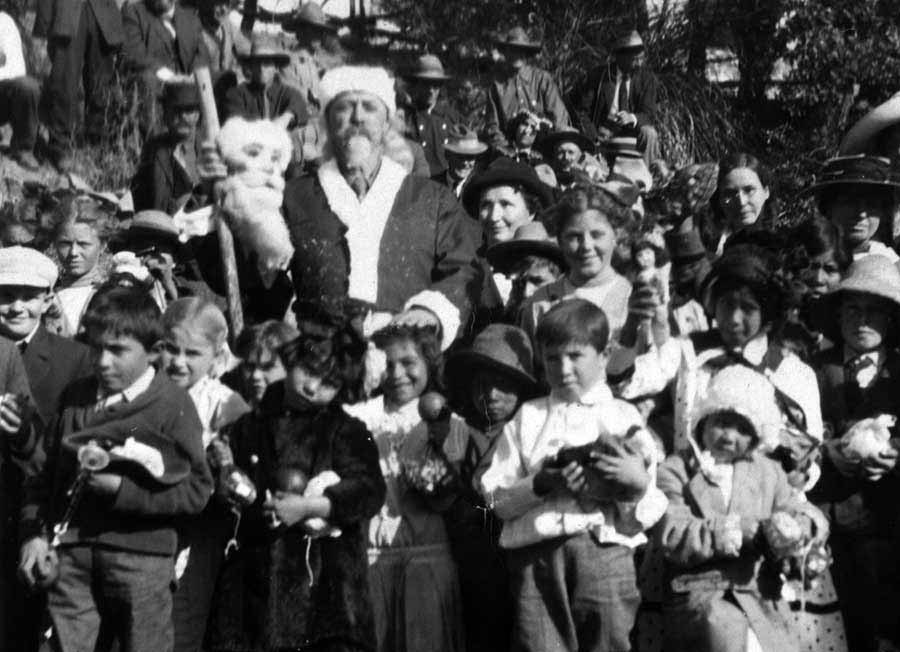
By Ruffin Prevost
It’s Christmas in Yellowstone National Park, but temperatures are soaring into the high 80s. It hasn’t snowed in months and visitors are wandering around in shorts and T-shirts while enjoying a sunny picnic with ice cream and cold drinks.
What might seem like a dystopian futuristic scenario of climate change at its worst extremes is actually a beloved and quirky Yellowstone tradition known as Savage Christmas, celebrated every Aug. 25.
Like so many elements of Yellowstone history, the origins of Savage Christmas are shrouded in apocryphal legends and weird juxtapositions of unlikely circumstances.
Still observed today with a Christmas tree, for instance, in the Old Faithful Inn in late August, Savage Christmas has its origins in summer celebrations and parades in the park dating to around World War II, said park historian Lee Whittlesey.
But according to (false) popular folklore, Savage Christmas started in the park’s unspecified “early days” when a group of visitors were trapped at the Old Faithful Inn after several inches of snow fell on Aug. 24, making stagecoach travel impossible. (Yellowstone’s stagecoach drivers were often called “savages” as a colorful term of endearment.)
The visitors, according to legend, decided to pass their snowbound time at the Inn by celebrating “Christmas” with carols, tree-trimming and other seasonal traditions. A cute story, but not at all factual, as weather records show there was never enough snow at the Inn in late August to hinder stagecoach travel. The truth behind Savage Christmas is less romantic, but perhaps just as interesting.
“The celebration really seems to have started as a private employee party that was called Savage Days,” Whittlesey said, with the tradition most likely dating to the late 1930s, based on a letter from Aubrey Haines, who was then an assistant district ranger at Old Faithful.
In the years before and just after World War II, concessions employees in the park would get together for a summer celebration each July or August, often dressing up in silly costumes and staging increasingly elaborate parties and parades around Old Faithful.
But Savage Days, which Whittlesey said was usually only a single-day event despite the plural name, had “gotten a little out of hand and become kind of a headache” by the early 1950s, leaving concessions managers worried that the celebrations were off-putting for guests and distracting for workers.
Around that same time, a new Christian ministry was starting in Yellowstone, according to an exhaustive history of Savage Christmas compiled by Leslie Quinn published in the summer 2001 edition of Yellowstone Science.
Whittlesey credits Quinn’s account of Savage Christmas as the definitive work on its origins. Quinn’s research found that Warren Ost, a bellman at Old Faithful Inn who was a Princeton divinity student, was the driving force behind the new Yellowstone Christian ministry.
By the early 1950s, choral groups at Old Faithful, Mammoth, Canyon and Lake were offering late summer performances of Handel’s Messiah, a traditional Christmas arrangement. Concessions managers, looking to phase out Savage Days, shifted that celebration to an Aug. 25 date eventually known as Savage Christmas.
Because there was no winter tourist season in the park at that time, it offered concessions workers a chance to celebrate “Christmas” early together, and to blow off steam near the end of the traditional summer tourism season, bonding and saying their goodbyes for the year over a quirky but heartfelt new tradition.
The tradition caught on with park workers, and became an annual event shared with summer visitors, with tour guides sometimes donning Santa Claus hats on Aug. 25, and park hotels setting up short-lived Christmas displays in their lobbies.
“The whole thing was a big show, as it is today,” Whittlesey said. “It’s kind of a great, big outdoor natural show, and our history gets all bound up in our nature.”
Contact Ruffin Prevost at 307-213-9818 or [email protected].

The tradition was also observed at Jenny Lake Lodge in Grand Teton National Park in the early 1970’s. It was basically just an excuse to have an employee party and exchange gifts. (former JLL employee)